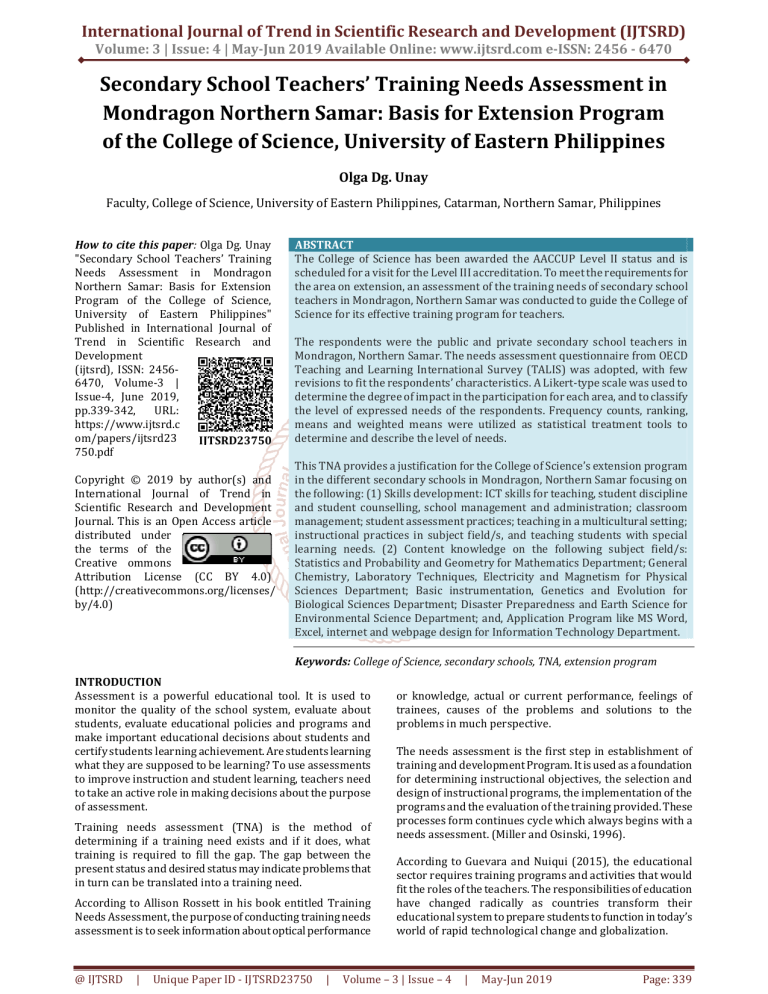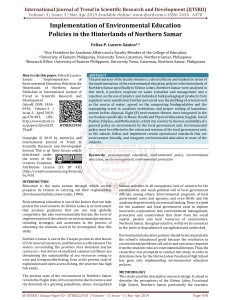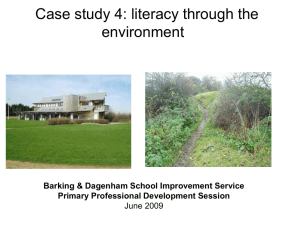
International Journal of Trend in Scientific Research and Development (IJTSRD)
Volume: 3 | Issue: 4 | May-Jun 2019 Available Online: www.ijtsrd.com e-ISSN: 2456 - 6470
Secondary School Teachers’ Training Needs Assessment in
Mondragon Northern Samar: Basis for Extension Program
of the College of Science, University of Eastern Philippines
Olga Dg. Unay
Faculty, College of Science, University of Eastern Philippines, Catarman, Northern Samar, Philippines
How to cite this paper: Olga Dg. Unay
"Secondary School Teachers’ Training
Needs Assessment in Mondragon
Northern Samar: Basis for Extension
Program of the College of Science,
University of Eastern Philippines"
Published in International Journal of
Trend in Scientific Research and
Development
(ijtsrd), ISSN: 24566470, Volume-3 |
Issue-4, June 2019,
pp.339-342,
URL:
https://www.ijtsrd.c
om/papers/ijtsrd23
IJTSRD23750
750.pdf
Copyright © 2019 by author(s) and
International Journal of Trend in
Scientific Research and Development
Journal. This is an Open Access article
distributed under
the terms of the
Creative ommons
Attribution License (CC BY 4.0)
(http://creativecommons.org/licenses/
by/4.0)
ABSTRACT
The College of Science has been awarded the AACCUP Level II status and is
scheduled for a visit for the Level III accreditation. To meet the requirements for
the area on extension, an assessment of the training needs of secondary school
teachers in Mondragon, Northern Samar was conducted to guide the College of
Science for its effective training program for teachers.
The respondents were the public and private secondary school teachers in
Mondragon, Northern Samar. The needs assessment questionnaire from OECD
Teaching and Learning International Survey (TALIS) was adopted, with few
revisions to fit the respondents’ characteristics. A Likert-type scale was used to
determine the degree of impact in the participation for each area, and to classify
the level of expressed needs of the respondents. Frequency counts, ranking,
means and weighted means were utilized as statistical treatment tools to
determine and describe the level of needs.
This TNA provides a justification for the College of Science’s extension program
in the different secondary schools in Mondragon, Northern Samar focusing on
the following: (1) Skills development: ICT skills for teaching, student discipline
and student counselling, school management and administration; classroom
management; student assessment practices; teaching in a multicultural setting;
instructional practices in subject field/s, and teaching students with special
learning needs. (2) Content knowledge on the following subject field/s:
Statistics and Probability and Geometry for Mathematics Department; General
Chemistry, Laboratory Techniques, Electricity and Magnetism for Physical
Sciences Department; Basic instrumentation, Genetics and Evolution for
Biological Sciences Department; Disaster Preparedness and Earth Science for
Environmental Science Department; and, Application Program like MS Word,
Excel, internet and webpage design for Information Technology Department.
Keywords: College of Science, secondary schools, TNA, extension program
INTRODUCTION
Assessment is a powerful educational tool. It is used to
monitor the quality of the school system, evaluate about
students, evaluate educational policies and programs and
make important educational decisions about students and
certify students learning achievement. Are students learning
what they are supposed to be learning? To use assessments
to improve instruction and student learning, teachers need
to take an active role in making decisions about the purpose
of assessment.
Training needs assessment (TNA) is the method of
determining if a training need exists and if it does, what
training is required to fill the gap. The gap between the
present status and desired status may indicate problems that
in turn can be translated into a training need.
According to Allison Rossett in his book entitled Training
Needs Assessment, the purpose of conducting training needs
assessment is to seek information about optical performance
@ IJTSRD
|
Unique Paper ID - IJTSRD23750
|
or knowledge, actual or current performance, feelings of
trainees, causes of the problems and solutions to the
problems in much perspective.
The needs assessment is the first step in establishment of
training and development Program. It is used as a foundation
for determining instructional objectives, the selection and
design of instructional programs, the implementation of the
programs and the evaluation of the training provided. These
processes form continues cycle which always begins with a
needs assessment. (Miller and Osinski, 1996).
According to Guevara and Nuiqui (2015), the educational
sector requires training programs and activities that would
fit the roles of the teachers. The responsibilities of education
have changed radically as countries transform their
educational system to prepare students to function in today’s
world of rapid technological change and globalization.
Volume – 3 | Issue – 4
|
May-Jun 2019
Page: 339
International Journal of Trend in Scientific Research and Development (IJTSRD) @ www.ijtsrd.com eISSN: 2456-6470
METHODOLOGY
This Training Needs assessment research used the
descriptive-survey method. The respondents of the study
were the secondary school teachers of Mondragon N. Samar.
There were 4 public and 1 private secondary schools in the
municipality of Mondragon N. Samar. A questionnaire was
the main instrument, consisting of two parts: respondent’
profile and the training needs of the teachers.
The needs assessment questionnaire from OECD Teaching
and Learning International Survey (TALIS) was used with a
few revisions in order to fit to the respondents.
The responses were classified and described as follows:
The degree of impact in the participation for each area were
also measured and interpreted as follows:
3.5 – 4.0
Large impact
2.5 – 3.49
Moderate impact
1.5 – 2.49
Small impact
1 – 1.49
No impact
The level of expressed needs were classified and interpreted
according to the following scales:
3.5 – 4.0
High level of need
2.5 – 3.49
Moderate level of need
1.5 – 2.49
Low level of need
1 – 1.49
No need at all
The data were tabulated. Frequency counts, ranking, means
and weighted means were utilized as statistical treatment
tools to determine and describe the level of needs.
RESULTS AND DISCUSSION
There were 156 secondary school teachers in Mondragon
Northern Samar. Majority of the respondents (26 or 74%)
were female. Ten (10) or 29% were aged between 25 to 30
years old and seven (7) or 20% were 40 to 45 years old. This
is an evidence that the respondents were below 50 years old.
A total of thirteen (13) or 37% were working for 3 to 5 years
and one (1) or 3% was working for 16 to 20 years in service.
This can be an indicative that the teachers were working
below 20 years in service.
Needs of the Teachers
Table1. Data on Secondary Teachers’ Participation in Professional Development Activities
Activity
Yes
No
Impact
None
Small
Moderate
Large
Weighted
f
%
f
%
1
impact 2
impact 3 impact 4
Mean
Courses/workshops
28 80 7 20
0
0
0
28
4.00
related to teaching
Education
33 94 2
6
0
0
8
25
3.76
conferences/seminars
Qualification/degree
20 57 15 43
0
0
5
15
3.75
program
Observation visits to
15 43 20 57
0
0
5
10
3.67
other schools
Participation in a
network of teachers
formed specifically for
25 71 15 43
0
0
11
14
3.56
the professional
development of teachers
Individual or
10 29 25 71
0
0
4
6
3.60
collaborative research
Mentoring, peer
27 77 8 23
0
0
9
18
3.67
observation and coaching
Reading professional
30 86 5 14
0
2
12
16
3.47
literature
dialogue with colleagues
on how to improve
0
0
9
18
3.67
27 77 8 23
teaching
INT
Large
Impact
Large
Impact
Large
Impact
Large
Impact
Large
Impact
Large
Impact
Large
Impact
Large
Impact
Large
Impact
Table 1 presents data on the teachers’ participation in professional development activities. Data from table showed that 33 or
94% of teachers participated in education conferences/seminars. Professional development activities keep teachers up-to-date
on new research on how students learn, emerging technology tools for the classroom, new curriculum resources and more.
Teachers need to be updated on the recent teaching techniques, strategies, knowledge and skills that they should possess. A
total of 30 or 86% were involved in reading professional literatures. The best professional development is ongoing,
experiential, collaborative and connected to and derived from working with students and understanding their culture. About 28
0r 80% attended courses/workshops related to teaching. There were 27 or 77% teachers who experienced mentoring, peer
observation and coaching, dialogue with colleagues on how to improve their teaching. Twenty five (25) or 71% participated in
a network of teachers formed specifically for the professional development of the teachers. About 15 or 43% wanted to
observation visits to other schools. An indication that teachers do not like to observe and visit other school because of the
requirement for such activities. Ten or 29% only were involved in individual or collaborative research. All of these activities
have a large impact on the teachers as education professionals.
The provision of development activities for teachers vary and should be based on their specific needs to ensure that the
teaching-learning process is effective.
@ IJTSRD
|
Unique Paper ID - IJTSRD23750
|
Volume – 3 | Issue – 4
|
May-Jun 2019
Page: 340
International Journal of Trend in Scientific Research and Development (IJTSRD) @ www.ijtsrd.com eISSN: 2456-6470
Table2. Secondary Education Teachers’ Expressed Professional Development Needs
Area
Weighted Mean Interpretation
Content and performance standards in subject field/s
3.89
High need
Student assessment practices
3.71
High need
Classroom management
3.77
High need
Knowledge and understanding of main subject field/s
3.86
High need
Knowledge and understanding of instructional practices in subject field/s
3.69
High need
ICT skills for teaching
3.94
High need
Teaching students with special learning needs
3.69
High need
Student discipline and behaviour problems
3.91
High need
School management and administration
3.83
High need
Teaching in a multicultural setting
3.71
High need
Student counseling
3.91
High need
Over-all Mean
4.191
High need
Rank
4
8.5
7
5
10.5
1
10.5
2.5
6
8.5
2.5
Data analysis indicated in table 2 showed that Secondary teachers expressed high needs for all the listed professional
development needs. Among the list, the ICT skills for teaching topped followed by student discipline and student counselling.
This implies that teachers need to update the new trends in teaching. The other areas identified to be highly needed are the
following: Content and performance standards in subject field/s, knowledge and understanding of main subject field, School
management and administration, Classroom management, , student assessment practices and Teaching in Multi-cultural
setting, Teaching students with special learning needs, Knowledge and understanding of instructional practices in subject
field/s.
Table3. Secondary Education Teachers’ Professional Subject Areas Needs
Mathematics
Weighted Mean
Interpretation
Rank
Algebra
2.56
Low need
4.5
Geometry
3.86
High need
2
Statistics and Probability
3.9
High need
1
Trigonometry
3.45
Moderately need
3
Others-Calculus
2.56
Low need
4.5
Biology
Basic Instrumentation
Science Processes
Genetics/Evolution
Animal Morphology/Physiology
Others
Chemistry
General Chemistry
Basic Instrumentation
Laboratory Techniques
Others Analytical Chemistry
Physics
Mechanics
Heat
Sound
Electricity
Magnetism
Others
Weighted Mean
3.86
3.6
3.86
2.56
Weighted Mean
3.83
3.6
3.6
3.86
3.86
Information Technology
Application Program
Internet
Webpage Design
Others
Environmental Studies
Environmental Education
Earth Science
Ecology
Environmental Management
Disaster Preparedness
Others
@ IJTSRD
|
Weighted Mean
3.83
3.6
3.83
3.4
Unique Paper ID - IJTSRD23750
|
Interpretation
High need
High need
High need
Moderately need
Rank
1.5
3
1.5
4
Interpretation
High need
High need
High need
Low need
Rank
1.5
3
1.5
4
Interpretation
High need
High need
High need
High need
High need
Rank
3
4.5
4.5
1.5
1.5
Weighted Mean
3.92
3.92
3.92
Interpretation
High need
High need
High need
Rank
1
1
1
Weighted Mean
3.6
3.86
2.56
3.6
3.92
Interpretation
High need
High need
Low need
High need
High need
Rank
4
2
5
3
1
Volume – 3 | Issue – 4
|
May-Jun 2019
Page: 341
International Journal of Trend in Scientific Research and Development (IJTSRD) @ www.ijtsrd.com eISSN: 2456-6470
Based on data shown in Table 3, the subject area which
ranked 1 in Mathematics is Statistics and Probability. For
Biology, the basic instrumentations and genetics/evolution
was tied at number 1. In the field of Chemistry, the areas
which ranked one were both General chemistry and
laboratory techniques while in Physics, electricity and
magnetism ranked number 1. In Information technology, all
three subjects’ areas ranked number 1. This implies that the
teachers need most the latest technology expertise in
teaching. Education cannot be globally competitive and
enhanced without Information and Communication
Technology. The disaster preparedness ranked number in
Environmental science. This is an indication that disaster
preparedness is vital nowadays.
CONCLUSIONS
This training need assessment study provides a justification
for an extension program in the different secondary schools
in Mondragon N. Samar.
RECOMMENDATIONS
The following are the recommendations as needs in the
development of the Extension program of the College of
Science: (1) ICT skills for teaching. (2) Student discipline and
behaviour problems. (3) Student counselling. (4) Content
and performance standards in subject field/s. (5) Knowledge
and understanding of main subject field/s. (6) School
management and administration. (7) Classroom
management. (8) Student assessment practices. (9) Teaching
in a multicultural setting. (10) Knowledge and
understanding of instructional practices in subject field/s.
(11) Teaching students with special learning needs.
For the secondary teachers, the following are the
recommended subjects in the development of the Extension
program of the College of Science. (1) Statistics and
Probability and Geometry for Mathematics Department. (2)
General Chemistry, Laboratory Techniques, Electricity and
Magnetism for Physical Sciences Department. (3) Basic
instrumentation, Genetics and Evolution for Biological
Sciences Department. (4) Disaster Preparedness and Earth
Science for Environmental Science Department. (5)
Application Program like MS Word, Excel, internet and
webpage design for Information Technology Department.
@ IJTSRD
|
Unique Paper ID - IJTSRD23750
|
REFERENCES:
[1] Rossett, Allison. Trainings Needs Assessment. 1987.
Retrieved June 2017 from https://books.google.com ›
Business & Economics › Management
[2] Miller, Janice A. SPHR and Diana M. Osinski, SPHR.
Trainings Needs Assessment. February 1996. Retrieved
June
2017
from
https://www.slideshare.net/iyyam_vj/miller-osinski
[3] Guevara, I., V. Nuqui, A. (2016). LCUP Administrators
and Teachers Training Needs Assessment: Basis for
Developing a Faculty Development Program, Journal of
Social Sciences & Humanities Research, 2(1). 1-14.
[4] Current Challenges in Basic Science Education.
Published by UNESCO, France, 2010. Retrieved June
2017
from:
unesdoc.unesco.org/images/0019/001914/191425e.p
df
[5] Sterling, Plata. DepEd’s 2015 Classroom Assessment
Reform: A Policy Analysis. 2016. Presented at the DLSU
Research Congress 2016, DLSU, Manila.
[6] Bello, Alhaja & Tijani, A.A. Trainings Needs of Teachers
in School-Based Assessment in Anglophone West
African Countries. Retrieved June 2017 from:
www.iaea.info/documents/paper_2fb24ab5.pdf
[7] Classroom Assessment at Jamaica’s Teachers Training
Colleges for Primary Teachers: A Needs Assessment.
IEQ Project, American Institutes for Research. 2000.
Retrieved
June
2017
from:
www.ieq.org/pdf/Classroom_Assessment-Jamaica.pdf
[8] Maligalig, Dalisay S., Jose Ramon G. Albert. Measures for
Assessing Basic Education in the Philippines.
Discussion Paper Series No. 2008-16. Philippine
Institute for Development Studies, Makati City,
Philippines. May 2008.
[9] Organisation for Economic Cooperation and
Development (OECD) Teaching and Learning Inventory
Survey (TALIS). Retrieved August 2016 from
htttp://www.oecd.org > edu > school.
Volume – 3 | Issue – 4
|
May-Jun 2019
Page: 342






